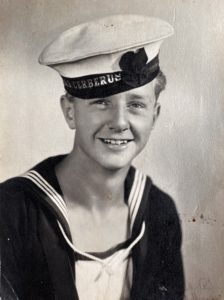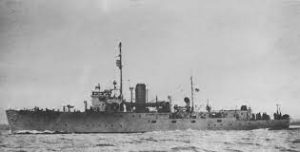- Author
- A.N. Other
- Subjects
- Biographies and personal histories, WWII operations
- Tags
-
- RAN Ships
- HMAS Armidale I
- Publication
- June 2021 edition of the Naval Historical Review (all rights reserved)
By Tony Caro
The December 2020 edition of this magazine contained a tribute to Teddy Sheean, our Victoria Cross recipient. Also mentioned were survivors rescued by HMAS Kalgoorlie, and amongst these lucky few was Able Seaman Russel Caro. The following brief story has been contributed by his son Mr Anthony (Tony) Caro.
After recuperating from the HMAS Armidale ordeal with his parents in Melbourne, Dad was assigned to the destroyer HMAS Quickmatch and returned to active service in the Pacific until the end of the war. Quickmatch was one of the first Australian naval ships to enter Yokohama Bay at the time of the Japanese surrender, and he wrote an interesting letter to his parents about the experience of visiting Tokyo days after the war was over.
He returned to Melbourne and worked for a short period in the family hardware business before a stint with a real estate agency drew him to the advertising industry.

Dad met his wife-to-be Patricia Sivyer in the early 1950s. Mum was an Ansett hostess flying around regional Australia at the time. They were soon married and settled in Brisbane, this being Mum’s home town. Dad’s sister Betty married Bill Lamshed, a fellow Armidale survivor and the four became lifelong friends.
He was a pretty handy tennis player, losing in doubles to Hoad and Rosewall 6-0, 6-1 in the Queensland Open at Kooyong, but forever proud of holding his serve and acing Rosewall to avoid a whitewash.
His work eventually led the family to Sydney in the early 1960s, where he continued in the advertising sector and eventually became Managing Director of his own successful firm, Pemberton Australia.
Dad had a major heart attack at 58, which led to his early retirement and a quieter, though fulfilling, happy life with Mum until his passing in 2000. He continued to play golf, to travel, and immersed himself in drawing and painting.
As was the wont of that generation, he rarely spoke of personal problems and particularly the trauma of the Armidaleordeal. I feel that the aftermath and poor treatment of the survivors by the RAN continued to distress him over his life, perhaps as much as the sinking and remarkable nine-day survival in the Timor Sea. Dad stayed in touch with the survivors, who but for one have all passed away. It is impossible to say how many times I would have seen him at the kitchen sink with a glass of tap water, declaring that when the survivors were collected by Kalgoorlie he made a promise to himself to ‘never go thirsty again’.

Wherever Dad is today, my sister Shelley and I know he is deeply moved, immensely proud, and relieved by this long overdue award of a posthumous Victoria Cross, for valour, to his shipmate Edward ‘Teddy’ Sheehan.
The following is part of a letter written to his parents by Russel Caro when serving in Quickmatch and subsequently published in a Victorian newspaper at the end of WWII.
The top of Fujiyama was barely visible through the early morning mists as the destroyer I am serving in weighed anchor and proceeded from Yokohama en route to Tokyo, I was feeling excited! This was to be my first shore run in…we often then joked about during the last four years when saying good-bye to a cobber. ‘See you in Tokyo’ we used to say.
Stepping off the ship at Shibaura wharf an hour later I found it hard to realise that I was actually in Japan’s principal city, for it had all seemed so far away, fighting around New Guinea in 1942.
It was a long walk up to the city, and transportation seemed to be almost at a standstill. A few trams, their green paint peeling off in large flakes, rattled past me and occasionally a sedan car with the words ‘Japanese Government’ printed on the front window. Those, together with a few Japanese bicycles, and sometimes an
old private car, were the only conveyances I saw still in use.
Everywhere I looked were houses and small factories, damaged or destroyed by bombs. The Japanese appeared to be very curious of the occupying forces, if you can tell behind their mask-like faces. Groups of men, dressed in some sort of uniform, stopped work immediately on my approach and stared at me until I was well past them. All the male population in Japan now and a large number of the women, seemed to wear a type of uniform.
As I drew nearer the city area the devastation became greater. Large areas were completely flattened out, and from the scraps of tin and wood that remained the Japanese had made themselves makeshift houses in which whole families were living.
Lining the pavements were burned out wrecks of motor cars and bicycles. The…men were right when they said there was nothing left in the town worth bombing. Walking was difficult, for rubble and twisted pieces of metal lay all over the pavements.
Coming into the city itself the picture was the same. Whole blocks were completely destroyed, and standing in the centre of the rubble were safes. It looked strange to see those safes; all that remained of what had perhaps been a block of offices or a departmental store.
The streets were crowded with people, Japanese civilians, US soldiers and sailors, Australian sailors and British sailors and marines. In front of the destroyed buildings in this street, were Japanese seated on the ground with all their goods set out before them, inviting customers. And they were getting them; the occupying troops after souvenirs to take back home, and the Japanese after odds and ends, such as frying pans and clothes pegs. Money appeared to be plentiful, and I saw little boys running around with great handfuls of banknotes.
Everything in the shops was being sold at colossal prices, and in what was left of big departmental stores like Takashima and Matsuya the price of material was marked at a thousand yen, about 20 pounds. I presume by the yard; and the smallest brooch or ornament cost nothing less than 50 yen – over a pound.
Fans were in great demand by the troops, and I saw many Australian sailors buying straw deckers, but for the greater part there was…The Japanese children attracted me; especially the tiny girls with their black hair shaved almost half way up to the backs of their heads. It was good fun to throw a few packets of chewing gum among a group of them and watch the scramble that followed. They must be very hungry!
I saw the Emperor’s Palace too, that morning, and I was impressed by the terrific amount of space occupied by the gardens around the palace, the wide moat and big walls surrounding the entire area. It looked strange to me to see the US guards standing at the entrance to Hirohito’s residence.
On the way back to the ship I thumbed a lift on a Japanese truck, and at the end of the ride I was thankful to see the last of that truck. The driver went so fast and took the corners so sharply that I again had to think I was in with a kamikaze boy.
But for all their boasting a few months previously that the whole nation would turn itself into a suicide corps if need be, the impression I gained was that the Japanese were an entirely defeated nation and glad to see the end of the war. The whole city was in ruins, no one appears to be doing a set job, and there is very little to buy. They have nothing!
Perhaps the words which sum up the situation best are the answer I received from a Japanese girl in Yokohama when I asked where I could get a kimono. ‘You can’t,’ she replied in English, with a lifeless and slightly sarcastic tone to her voice, ‘You’ve burnt them all.’




